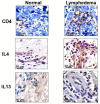Histopathologic Features of Lymphedema: A Molecular Review
- PMID: 32268536
- PMCID: PMC7177532
- DOI: 10.3390/ijms21072546
Histopathologic Features of Lymphedema: A Molecular Review
Abstract
An estimated 5 million people in the United States are affected by secondary lymphedema, with most cases attributed to malignancies or malignancy-related treatments. The pathogenesis of secondary lymphedema has historically been attributed to lymphatic injury or dysfunction; however, recent studies illustrate the complexity of lymphedema as a disease process in which many of its clinical features such as inflammation, fibrosis, adipogenesis, and recurrent infections contribute to on-going lymphatic dysfunction in a vicious cycle. Investigations into the molecular underpinning of these features further our understanding of the pathophysiology of this disease and suggests new therapeutics.
Keywords: adipogenesis; fibrosis; immunity; inflammation; inflammatory skin conditions; lymphedema; recurrent infections.
Conflict of interest statement
The authors declare no conflict of interest.
Figures


References
-
- McLaughlin S.A., Wright M.J., Morris K.T., Giron G.L., Sampson M.R., Brockway J.P., Hurley K.E., Riedel E.R., Van Zee K.J. Prevalence of lymphedema in women with breast cancer 5 years after sentinel lymph node biopsy or axillary dissection: Objective measurements. J. Clin. Oncol. Off. J. Am. Soc. Clin. Oncol. 2008;26:5213–5219. doi: 10.1200/JCO.2008.16.3725. - DOI - PMC - PubMed
-
- Todo Y., Yamamoto R., Minobe S., Suzuki Y., Takeshi U., Nakatani M., Aoyagi Y., Ohba Y., Okamoto K., Kato H. Risk factors for postoperative lower-extremity lymphedema in endometrial cancer survivors who had treatment including lymphadenectomy. Gynecol. Oncol. 2010;119:60–64. doi: 10.1016/j.ygyno.2010.06.018. - DOI - PubMed
Publication types
MeSH terms
Grants and funding
LinkOut - more resources
Full Text Sources
Medical

